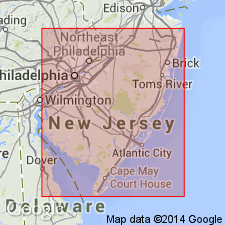
- Usage in publication:
-
- Redbank formation
- Modifications:
-
- Named
- Dominant lithology:
-
- Sand
- Greensand
- AAPG geologic province:
-
- Atlantic Coast basin
Summary:
Redbank sand named in Monmouth Co., NJ. Consists bright-red sands, glauconitic throughout, but abundance of coarse arenaceous sediments has aided oxidation of greensand, changing green color to red or brown. Lower part often black sand or sandy clay. At top, an indurated clayey layer, generally of greenish color. Thickness 100 ft. Is Red Sand of previous reports. Underlies Rancocas formation [group] and overlies Navesink formation. Well developed in vicinity of Red Bank, Monmouth Co.
Source: GNU records (USGS DDS-6; Reston GNULEX).
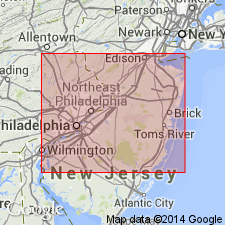
- Usage in publication:
-
- Redbank sand
- Modifications:
-
- Revised
- AAPG geologic province:
-
- Atlantic Coast basin
Summary:
Redbank sand restricted. 22-ft-thick beds at top removed from Redbank and referred to Tinton beds.
Source: GNU records (USGS DDS-6; Reston GNULEX).
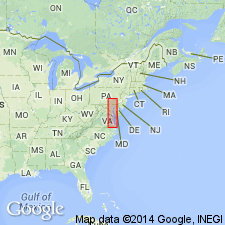
- Usage in publication:
-
- Red Bank member
- Modifications:
-
- Revised
- AAPG geologic province:
-
- Atlantic Coast basin
Summary:
Red Bank reduced to member status in Monmouth formation. Conformably overlies Navesink member; conformably underlies Tinton member; toward south where Tinton is missing, Red Bank grades into overlying Hornerstown. Thickness in Monmouth Co. is 125 ft; thins to southeast and not present south of Sykesville. Decreases in thickness as sand member basinward or downdip and becomes more and more shaly and is inseparable from Hornerstown or Navesink.
Source: GNU records (USGS DDS-6; Reston GNULEX).
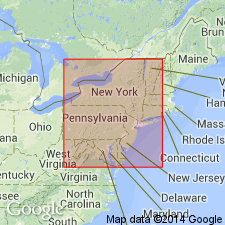
- Usage in publication:
-
- Red Bank Formation
- Modifications:
-
- Overview
- AAPG geologic province:
-
- Atlantic Coast basin
Summary:
The main body of the Red Bank Formation of the Monmouth Group is a coarse yellowish to reddish brown feldspathic quartz sand referred to as the Shrewsbury Member. The basal portion is a dark gray silty clayey fine quartz sand called the Sandy Hook Member. Owens and Sohl (1969) recognized a third facies, a glauconitic sand overlying the Navesink Formation further to the southwest along strike. This unit replaces the lower Sandy Hook Member, grading into and resembling the underlying Navesink. The Sandy Hook ranges from 3 m to 10.5 m in outcrop, the Shrewsbury reaches a maximum of 24 m, and the glauconitic facies reaches 9 m near New Egypt, Monmouth Co. Marine invertebrates are locally abundant in the Sandy Hook Member. The formation is restricted to Monmouth Co in the northeast section of the Upper Cretaceous outcrop belt. Exposed at Matawan, Atlantic Highlands, Poricy Brook, Big Brook, and Beers Hill. Loses its identity in the shallow subsurface. Underlies the Tinton Formation. Age is middle to late Maastrichtian according to Jordan and Smith (1983).
Source: GNU records (USGS DDS-6; Reston GNULEX).
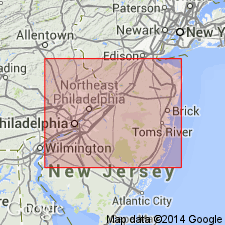
- Usage in publication:
-
- Red Bank Formation
- Modifications:
-
- Overview
- AAPG geologic province:
-
- Atlantic Coast basin
Summary:
The Maastrichtian unconformity-bounded sequence in the NJ coastal plain, here informally termed the Navesink sequence, includes the Navesink Formation, the Sandy Hook and Shrewsbury Members of the Red Bank Formation, and the Tinton Formation and ranges in age from 69.3 to 65 Ma based on Sr-isotope age estimates. Sequence is assigned to the calcareous nannofossil Zones CC20/21 and CC22b. High sedimentation rates in the latest Maastrichtian of NJ suggest tectonic uplift and/or rapid progradation during deposition of the highstand systems tract. The unconformable contact with the Campanian Mount Laurel Formation of the underlying Marshalltown sequence is marked by a reworked zone of a pebbly, poorly sorted, glauconite-quartz sand. The Navesink Formation is the transgressive, basal, clayey glauconite sand in a coarsening-upward sedimentary sequence. It is interpreted to be a middle-shelf deposit with large beds of calcareous shells dispersed throughout. The overlying Sandy Hook Member of the Red Bank is a massive, dark-gray, micaceous, fossiliferous, clayey silt and fine sand that grades upward into the Shrewsbury Member, a burrowed, slightly glauconitic, medium to coarse quartz sand that is unfossiliferous because of leaching. The sequence changes dramatically to the southwest along the outcrop belt. The Shrewsbury Member pinches out near New Egypt; the Sandy Hook changes from clayey fine sand to glauconite sand and pinches out several mi to the west of New Egypt, and the Navesink Formation thins or is locally absent. The Tinton Formation, uppermost Maastrichtian unit in NJ, crops out in a northern belt extending from the Atlantic Highlands southwestward to Perrineville and reaches a maximum thickness of 11 m just west of its type section. The Tinton is an unconsolidated to well-indurated, clayey, feldspathic, glauconite-quartz sand. The sequence unconformably underlies the Hornerstown Formation, dated as either Maastrichtian and early Paleocene or entirely early Paleocene.
Source: GNU records (USGS DDS-6; Reston GNULEX).
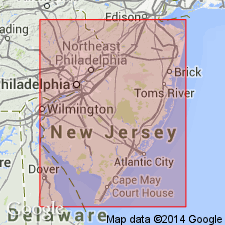
- Usage in publication:
-
- Red Bank Formation*
- Modifications:
-
- Overview
- AAPG geologic province:
-
- Atlantic Coast basin
Summary:
The Red Bank Formation in New Jersey consists of two thick and one thin lithofacies. The thick lower facies (Sandy Hook Member) and thick upper facies (Shrewsbury Member) thin and change toward the southwest where they merge with the thin, dark-gray, very micaceous, quartz-glauconite sand. The Red Bank only outcrops in northern NJ Coastal Plain. Overlies the Navesink Formation and underlies the Tinton Formation. The Red Bank is of late middle and late Maastrichtian age.
Source: GNU records (USGS DDS-6; Reston GNULEX).
For more information, please contact Nancy Stamm, Geologic Names Committee Secretary.
Asterisk (*) indicates published by U.S. Geological Survey authors.
"No current usage" (†) implies that a name has been abandoned or has fallen into disuse. Former usage and, if known, replacement name given in parentheses ( ).
Slash (/) indicates name conflicts with nomenclatural guidelines (CSN, 1933; ACSN, 1961, 1970; NACSN, 1983, 2005, 2021). May be explained within brackets ([ ]).

